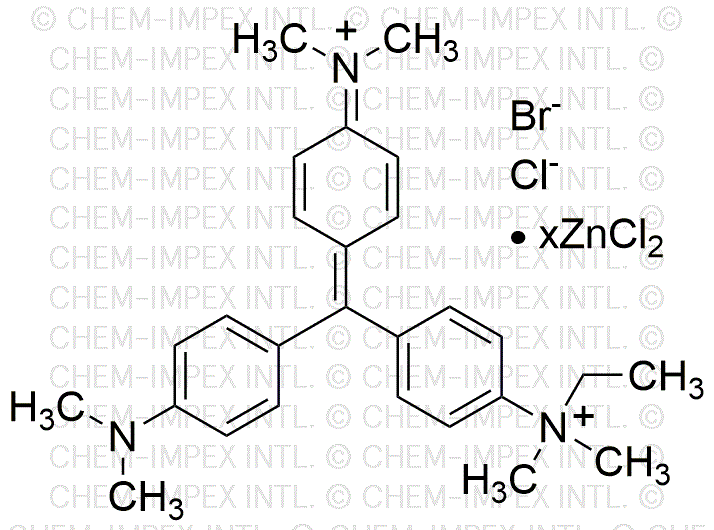Methyl green zinc chloride salt is widely utilized in research focused on:
- Histology and Cytology: This compound is commonly used as a staining agent in microscopy. It helps researchers visualize cellular structures and differentiate between living and dead cells, making it invaluable in biological studies.
- Biochemical Assays: Methyl green zinc chloride salt serves as a pH indicator and a reagent in various biochemical assays, aiding in the detection of nucleic acids and proteins. This application is crucial for molecular biology research.
- Pharmaceutical Development: In the pharmaceutical industry, it is used in the formulation of certain drugs, enhancing their stability and effectiveness. Its unique properties allow for improved drug delivery systems.
- Environmental Testing: This compound is employed in environmental science to assess the presence of heavy metals and pollutants in water samples, contributing to ecological monitoring and safety assessments.
- Educational Purposes: Methyl green zinc chloride salt is frequently used in educational laboratories for teaching purposes, helping students understand chemical reactions and staining techniques in a hands-on manner.
General Information
Properties
Safety and Regulations
Applications
Methyl green zinc chloride salt is widely utilized in research focused on:
- Histology and Cytology: This compound is commonly used as a staining agent in microscopy. It helps researchers visualize cellular structures and differentiate between living and dead cells, making it invaluable in biological studies.
- Biochemical Assays: Methyl green zinc chloride salt serves as a pH indicator and a reagent in various biochemical assays, aiding in the detection of nucleic acids and proteins. This application is crucial for molecular biology research.
- Pharmaceutical Development: In the pharmaceutical industry, it is used in the formulation of certain drugs, enhancing their stability and effectiveness. Its unique properties allow for improved drug delivery systems.
- Environmental Testing: This compound is employed in environmental science to assess the presence of heavy metals and pollutants in water samples, contributing to ecological monitoring and safety assessments.
- Educational Purposes: Methyl green zinc chloride salt is frequently used in educational laboratories for teaching purposes, helping students understand chemical reactions and staining techniques in a hands-on manner.
Documents
Safety Data Sheets (SDS)
The SDS provides comprehensive safety information on handling, storage, and disposal of the product.
Product Specification (PS)
The PS provides a comprehensive breakdown of the product’s properties, including chemical composition, physical state, purity, and storage requirements. It also details acceptable quality ranges and the product's intended applications.
Certificates of Analysis (COA)
Search for Certificates of Analysis (COA) by entering the products Lot Number. Lot and Batch Numbers can be found on a product’s label following the words ‘Lot’ or ‘Batch’.
*Catalog Number
*Lot Number
Certificates Of Origin (COO)
This COO confirms the country where the product was manufactured, and also details the materials and components used in it and whether it is derived from natural, synthetic, or other specific sources. This certificate may be required for customs, trade, and regulatory compliance.
*Catalog Number
*Lot Number
Safety Data Sheets (SDS)
The SDS provides comprehensive safety information on handling, storage, and disposal of the product.
DownloadProduct Specification (PS)
The PS provides a comprehensive breakdown of the product’s properties, including chemical composition, physical state, purity, and storage requirements. It also details acceptable quality ranges and the product's intended applications.
DownloadCertificates of Analysis (COA)
Search for Certificates of Analysis (COA) by entering the products Lot Number. Lot and Batch Numbers can be found on a product’s label following the words ‘Lot’ or ‘Batch’.
*Catalog Number
*Lot Number
Certificates Of Origin (COO)
This COO confirms the country where the product was manufactured, and also details the materials and components used in it and whether it is derived from natural, synthetic, or other specific sources. This certificate may be required for customs, trade, and regulatory compliance.


